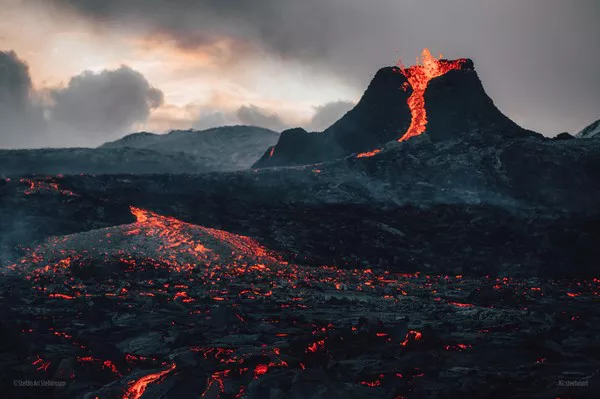From towering peaks spewing molten lava to majestic landscapes shaped by volcanic activity, the world’s highest active volcanoes captivate with their beauty and power. These geological wonders, often found in regions of tectonic activity and volcanic hotspots, command awe and respect, reminding us of Earth’s dynamic nature. In this article, we delve into the top ten highest active volcanoes in the world, exploring their characteristics, historical eruptions, and significance in shaping the landscape and environment.
Top 10 Highest Active Volcanoes in the World
1. Ojos del Salado (6,893 meters/22,615 feet)
Located in the Andes Mountains on the border between Chile and Argentina, Ojos del Salado holds the distinction of being the world’s highest active volcano. Standing at an impressive elevation of 6,893 meters (22,615 feet), Ojos del Salado is part of the Central Volcanic Zone of the Andes and is known for its rugged beauty and extreme conditions. Despite its high altitude and icy surroundings, Ojos del Salado exhibits occasional volcanic activity, with its last confirmed eruption occurring in 1993.
2. Llullaillaco (6,739 meters/22,109 feet)
Situated in the Andes Mountains along the border between Chile and Argentina, Llullaillaco ranks as the world’s second-highest active volcano. With an elevation of 6,739 meters (22,109 feet), Llullaillaco is part of the Central Volcanic Zone of the Andes and is notable for its archaeological significance. The volcano is home to the highest archaeological site in the world, where the remarkably well-preserved mummies of three Inca children were discovered in 1999. Despite its remote location and frigid conditions, Llullaillaco exhibits signs of ongoing volcanic activity.
3. Chimborazo (6,263 meters/20,548 feet)
Nestled in the Ecuadorian Andes, Chimborazo is the highest peak in Ecuador and the highest active volcano outside of the Himalayas. With an elevation of 6,263 meters (20,548 feet), Chimborazo is a stratovolcano that last erupted over 10,000 years ago. Despite its dormant status, Chimborazo remains an iconic landmark and a popular destination for mountaineers and adventurers seeking to conquer its lofty summit.
4. Cotopaxi (5,897 meters/19,347 feet)
Located in the Ecuadorian Andes, Cotopaxi is one of the world’s highest active volcanoes and a prominent symbol of Ecuador. With an elevation of 5,897 meters (19,347 feet), Cotopaxi is renowned for its perfect conical shape and frequent eruptions throughout history. The volcano’s last significant eruption occurred in 2015-2016, prompting evacuations and concerns about ashfall and lahars. Despite its active status, Cotopaxi remains a popular destination for climbers and tourists drawn to its breathtaking beauty and geological significance.
5. Mount Kilimanjaro (5,895 meters/19,341 feet)
Located in Tanzania, Mount Kilimanjaro is Africa’s highest peak and one of the world’s tallest free-standing mountains. With an elevation of 5,895 meters (19,341 feet), Kilimanjaro is a dormant stratovolcano composed of three distinct cones: Kibo, Mawenzi, and Shira. While Kilimanjaro is not currently active, its volcanic history is evident in the crater and volcanic ash found on its slopes. Kilimanjaro’s iconic snow-capped summit and diverse ecosystems make it a popular destination for climbers and nature enthusiasts from around the world.
6. Mount Elbrus (5,642 meters/18,510 feet)
Situated in the Caucasus Mountains of Russia, Mount Elbrus is Europe’s highest peak and one of the world’s highest active volcanoes. With an elevation of 5,642 meters (18,510 feet), Mount Elbrus is a dormant stratovolcano composed of two main summits: the west summit (5,642 meters) and the slightly lower east summit (5,621 meters). While Mount Elbrus has not erupted in recorded history, its volcanic activity is evident in the presence of hot springs and fumaroles on its slopes. Mount Elbrus is a popular destination for mountaineers and adventurers seeking to conquer Europe’s highest peak.
7. Mount Damavand (5,610 meters/18,405 feet)
Located in Iran, Mount Damavand is the highest peak in the Middle East and one of the world’s highest active volcanoes. With an elevation of 5,610 meters (18,405 feet), Mount Damavand is a stratovolcano characterized by its conical shape and volcanic activity. While Mount Damavand’s last eruption occurred over 7,000 years ago, the volcano remains seismically active, with occasional fumarole activity and sulfur deposits on its summit. Mount Damavand is a symbol of Iranian culture and heritage, revered as a national symbol and a popular destination for hikers and climbers.
8. Mount Erebus (3,794 meters/12,448 feet)
Situated on Ross Island in Antarctica, Mount Erebus is the southernmost active volcano on Earth and one of the world’s highest volcanoes outside of the Andes. With an elevation of 3,794 meters (12,448 feet), Mount Erebus is a stratovolcano characterized by its persistent lava lake and ongoing volcanic activity. Despite its remote and inhospitable location, Mount Erebus is a focus of scientific research and exploration, offering insights into volcanic processes, geothermal energy, and astrobiology.
9. Mount Nyiragongo (3,470 meters/11,385 feet)
Located in the Democratic Republic of the Congo, Mount Nyiragongo is one of Africa’s most active and dangerous volcanoes. With an elevation of 3,470 meters (11,385 feet), Mount Nyiragongo is renowned for its lava lake and frequent eruptions, which pose significant risks to nearby communities. The volcano’s last major eruption occurred in 2002, resulting in the loss of life and widespread destruction in the city of Goma. Despite ongoing monitoring and scientific research, Mount Nyiragongo remains a potent reminder of the power and unpredictability of volcanic activity.
10. Mount Merapi (2,930 meters/9,613 feet)
Located on the island of Java in Indonesia, Mount Merapi is one of the world’s most active and deadliest volcanoes. With an elevation of 2,930 meters (9,613 feet), Mount Merapi is a stratovolcano characterized by its frequent eruptions and pyroclastic flows. The volcano’s last major eruption occurred in 2010, resulting in significant loss of life and widespread destruction in the surrounding area. Despite its volcanic hazards, Mount Merapi is revered as a sacred site and a symbol of Indonesia’s rich cultural heritage.
In conclusion, the world’s highest active volcanoes are awe-inspiring natural wonders that shape landscapes, ecosystems, and human societies. From the towering peaks of the Andes to the icy slopes of Antarctica, these volcanoes remind us of Earth’s dynamic and ever-changing nature. While their beauty and majesty captivate the imagination, their potential for eruption and devastation underscore the importance of scientific research, monitoring, and preparedness in mitigating volcanic hazards and protecting vulnerable communities. As we continue to explore and understand these volcanic giants, we gain valuable insights into the forces that shape our planet and the delicate balance between human civilization and the forces of nature.
You Might Be Interested In:



























